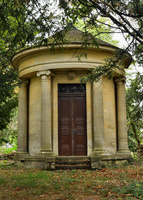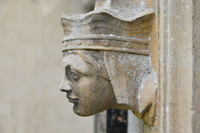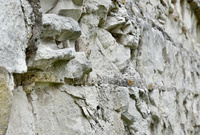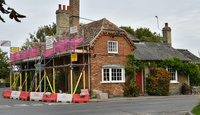You must be a member to visit this group
In 970, the land around Newton in South Cambridgeshire was given by its previous owner to King Edgar the Peaceful, who was known for introducing a period of political stability to England. Edgar planned to give it to the new abbey at Ely, around 30 miles away, but died and was buried at Glastonbury Abbey in 975 before the transfer was legally complete, and the abbey at Ely had to buy the land instead.
It would have been at about that time that a chapel was first built at Newton and, over the following couple of centuries, it was developed; some parts of it are believed to be incorporated into a new structure which gradually grew to become the present church - though it too remained technically a chapel until 1346 when it was consecrated and dedicated to St James.
Newton remained in the ownership of the Abbey of Ely until the Dissolution of the Monasteries in 1539, at which point it was given by the crown to the aristocratic Hurrell family who still own it to this day. Much of the village was destroyed by fire in 1746; perhaps in an attempt to gain special treatment for the poor folk of the village, the church was re-dedicated to St Margaret, the patron saint of peasants.
Also in the village is the Queen's Head pub, which has been trading continuously since 1729 - meaning it's been in business for 47 years longer than the USA.



Enjoy being online again!
Welcome to the community of good people who base their values on evidence and appreciate civil discourse - the social network you will enjoy.Create your free account
10 comments
Feel free to reply to any comment by clicking the "Reply" button.This is Trim Castle ...it is the largest Norman castle in Europe...and is a few hundred yards from my house in Trim Co.Meath.
It is also famous for its use in the film Braveheart.
I am surrounded with ancient and medieval castles..churches..abbeys..burial grounds..its really fantastic here.
Jnei:
@PalacinkyPDX Oh, I thought that was next door's kids!
You must be very near Newgrange....it must be older than anything else listed here.
Yes just a short drive from the Hill of Tara..Newgrange..loughcrew..knowth..and the Priory of John the Baptist is literally at the bottom of the road on the Boyne.
@Hitchens Great area, we had friends who lived near Trim. Other friends in Mullingar, a bit further from you.
I remember I was annoyed that they hadn’t filmed Braveheart in Scotland when I heard that! The history was all wrong anyway! I expect it had a lot to do with the incentives given to the filmmakers in the form of tax breaks.
Yes..I love Trim...its officially designated as a Heritage Town...it has a different vibe to the other towns in Meath.
You were right to get annoyed by that...It really should have been filmed on the correct location...and the film itself had little or no bearing on actual historical events..but it was great fun though..?
@Hitchens Yes a lot of hokum, but a great watch nevertheless!
About a hundred miles south of me at Newgrange in Co,Meath there is a megolithic site called the Driud’s Altar which is older than Stonehenge and the Egyptian Pyramids and dates back to 8th/9th millennia BC.
Interesting. I live a couple of miles from a number of Visigothic tombs. The Visigoths ruled Spain from 410 to around 800. No photos though! I'll try and find some. Anyone live near something even earlier?
Jnei:
I do - there are numerous burial barrows around here, some dating from the Bronze Age and even earlier! Plenty of Neolithic sites in Devon, too.
Jnei:
@PalacinkyPDX I hope they get it back one day!
@Jnei I'm not sure whether Spain or the UK would come out on top in the 'Who can go back further'
stakes! I think probably Spain. The attitude to historical sites here in Spain is a bit cavalier though. There are so many that they only spend money on the most famous ones. The others depend on someone local being interested.
@Jnei, @PalacinkyPDX That is really sad.I'm afraid your troops did a lot of damage to historical sites in Iraq, too. here in Spain they try not to damage or build over ancient sites but they don't have to money to develop them all to educate people.
Jnei:
@CeliaVL @PalacinkyPDX If we go on traces left by human ancestors, Spain has the edge with a Homo antecessor jawbone discovered at Atapuerca and dated to about 1.2 million years ago. Britain's oldest traces are footprints (the oldest ever discovered outside Africa), thought to have been made by H. antecessor, found at Happisburgh in Norfolk and dated to 950,000 years ago.
If we only consider buildings, Britain wins easily thanks to the Knap of Howar, a 5700 year old stone house in Scotland; whereas Spain's oldest, the Dolmen de Viera, is a "mere" 4000 years old (France beats both though, with the 6850 year old Cairn of Barnenez).
Enjoy being online again!
Welcome to the community of good people who base their values on evidence and appreciate civil discourse - the social network you will enjoy.Create your free account
Share this post
Categories
Agnostic does not evaluate or guarantee the accuracy of any content. Read full disclaimer.














